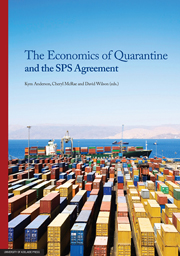Book contents
- Frontmatter
- Contents
- List of tables, figures and boxes
- Acronyms
- Preface
- List of contributors
- 1 Introduction
- PART I The multilateral rules under WTO
- PART II The ‘appropriate level of protection’
- 6 Appropriate level of protection: a European perspective
- 7 Appropriate level of protection: an Australian perspective
- 8 Appropriate level of protection: a New Zealand perspective
- 9 Beyond iso-risk to include benefits under the SPS Agreement
- 10 Integrating import risk and trade benefit analysis
- PART III Adding more economics to risk analysis
- PART IV Specific health and environmental risks from trade
- PART V Conclusion
- APPENDIX The legal text of the SPS Agreement
9 - Beyond iso-risk to include benefits under the SPS Agreement
from PART II - The ‘appropriate level of protection’
Published online by Cambridge University Press: 05 June 2013
- Frontmatter
- Contents
- List of tables, figures and boxes
- Acronyms
- Preface
- List of contributors
- 1 Introduction
- PART I The multilateral rules under WTO
- PART II The ‘appropriate level of protection’
- 6 Appropriate level of protection: a European perspective
- 7 Appropriate level of protection: an Australian perspective
- 8 Appropriate level of protection: a New Zealand perspective
- 9 Beyond iso-risk to include benefits under the SPS Agreement
- 10 Integrating import risk and trade benefit analysis
- PART III Adding more economics to risk analysis
- PART IV Specific health and environmental risks from trade
- PART V Conclusion
- APPENDIX The legal text of the SPS Agreement
Summary
Countries restrict imports through quarantine controls to reduce the risks and expected costs of pest and disease incursions. Countries have also used trade barriers such as import tariffs and quotas to protect domestic industries against competition from imports. The higher benefits that could be obtained under freer trade regimes have prompted international agreements to liberalise trade under the General Agreement on Tariff and Trade (GATT) and, its successor, the World Trade Organization (WTO).
Under the WTO Agreement on the Application of Sanitary and Phytosanitary Measures, a Member has the sovereign right to determine the level of sanitary and phytosanitary protection it deems appropriate and to institute plant and animal health and food safety measures to protect against bona fide risks. Sanitary and phytosanitary measures, such as disease-free certification requirements, are instruments that importing countries use to lower the risk of pest and disease incursion. To prevent the use of SPS measures as disguised trade barriers, WTO Members can institute SPS measures provided they are:
based on a sound scientific assessment process;
not more trade-restrictive than necessary to achieve the desired level of protection against pests and diseases; and
nondiscriminatory - sanitary and phytosanitary measures must not discriminate between Members where identical or similar conditions prevail, including between their own territory and that of Members.
Implementing SPS measures that meet these guidelines in a consistent manner within and between countries is proving to be difficult and several Member countries, including Australia, have been drawn into the lengthy and expensive WTO dispute settlement process. This inability to establish consistent SPS protocols may lead to a greater number of disputes in the future and reduce the effectiveness of the SPS Agreement to facilitate trade.
- Type
- Chapter
- Information
- The Economics of Quarantine and the SPS Agreement , pp. 164 - 173Publisher: The University of Adelaide PressPrint publication year: 2012

